Masterpieces
in metal
TEXT BY T.S. SUBRAMANIAN & PHOTOGRAPHS BY D.
KRISHNAN
The millennium celebrations of the Brihadisvara temple in Thanjavur
showcased the largest collection of Chola bronzes ever.
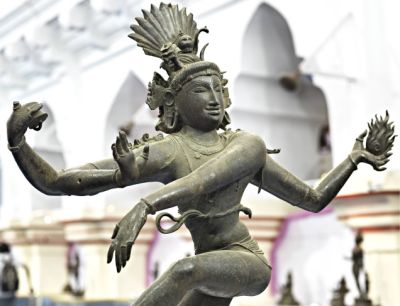
NATARAJA OF TIRUVALANGADU. This bronze belongs
to the period of Raja Raja Chola (regnal years 985-1014 CE). The
hand at the top on his right side plays the damaru and the one
below depicts the 'abhaya' (protection) mudra. On the left side,
the hand at the top holds a flame of nine tongues, representing
the continuum of energy, and the one below is in the 'gaja-hasta'
pose (like an elephant's trunk). The pendant on the necklace has
moved from its original position, a touch of realism. The 'tiruvasi'
(arch) and the flying hair, so characteristic of Nataraja bronzes,
are missing. They either broke off or were stolen.
IT was a gallery that defied description. It held the largest
collection of Chola bronzes ever assembled in one place –
76 masterpieces in all, the majority of them crafted during the
reign of Raja Raja Chola, the Chola emperor (regnal years 985-1014
CE) who built Raja Rajesvaram, or the Brihadisvara temple, in
Thanjavur, Tamil Nadu. The gallery, set up at the Thanjavur Palace,
was the centrepiece of the millennium celebrations of the temple,
an “architectural audacity” in itself, organised by
the Tamil Nadu government from September 22 to 26.
Among the images on display were Nataraja (of Tiruvalangadu
near Chennai); Ardhanarisvara, Bhikshatana, an eight-armed Siva
and the expressive Kannappa Nayanar (all belonging to Tiruvengadu
near Thanjavur); the Buddhas of Nagapattinam; the Tirtankaras
of Tindivanam; and Velan of Gangaikonda Cholapuram, which belongs
to the period of Rajendra Chola (regnal years 1012-1044 CE) and
was being displayed for the first time. Also on view were exquisite
bronzes of Kali and Neesumbasudani, both with eight arms; a “rare”
Veenadhara Dakshinamurthy; Saivite saints Karaikaal Ammaiyar,
Tirugnana Sambandar, Appar, Sundarar and Manickavasagar; and Krishna
with Sathyabhama and Rukmani.
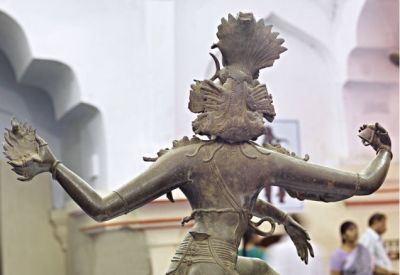
"The grandeur" of the conception of "Ananda
tandava", as depicted by Nataraja of Tiruvalangadu, is "a
synthesis of science and religion and art", writes Ananda
K. Coomaraswamy. The view from the back shows the perfection the
sthapathis achieved in representing the twists and turns of the
body.
The earliest of the pieces, dating to the 8th century CE, was
of the Somaskanda group, which originally comprised Siva, Parvati
and their child Skanda seated between them, but is now without
the child. Bronzes discovered at Tiruindalur, Velankanni and Tiruvarur
in May, July and August 2010 respectively, were also on display.
The artefacts stand testimony to the perfection the atliers of
the Chola period had achieved in the art of metal casting.
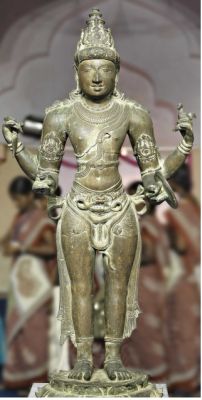
VELAN (SUBRAHMANYA) OF Gangaikonda Cholapuram.
In battle gear and sporting a beautiful smile, he is ready to
fight the demon Surapadman at sea. Rajendra Chola consecrated
this bronze in the Gangaikonda Cholisvaram temple to commemorate
his conquest of Kedah, Sumatra and Java. Velan wears a 'karanda
makuta', or tiered crown; a headband; 'makara kundala', or earrings
shaped like fish (above and close-up, below).
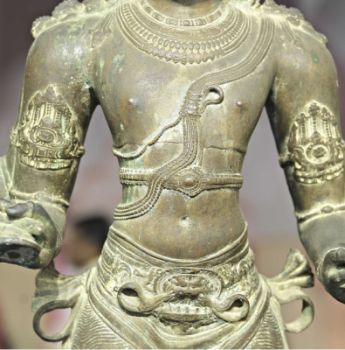
An 'udara banda', or stomach band; and three pearl
necklaces. He has heavily ornamented arm bands and the yajno-pavite
runs across his chest. The dhoti is held in place by a simhaclasp,
a buckle that resembles a lion. On the right side, in the hand
at the top is the Sakthi Padai, a weapon given by his mother Parvati.
The other hand, which is broken, must have held "Vajra",
the weapon given by Indra. On the left side, the hand at the top
holds a rooster, his symbol, and the other a shield.
The lithic inscriptions in the Brihadisvara temple provide a list
of 66 beautiful bronzes that Raja Raja Chola, his sister Kundavai,
his queens and his commanders gifted to the temple. The inscriptions
have a wealth of information on the enormous amounts of jewellery
the Chola emperor, his queens and his officers donated to adorn
these bronzes, which were processional deities that were taken
out during temple festivals.
The inscriptions reveal that Raja Raja Chola named
the bronze of a dancing Siva, called Dakshina Meru Vitankar, “Adavallan”
(expert in dance). Today, of the 66 bronzes, only this and another,
of Siva's consort Sivakami, remain in the Brihadisvara temple
(Frontline, July 2, 2010).
In his book Rajarajesvaram, the Pinnacle of Chola
Art (published by Mudgala Trust in 1985), B. Venkataraman says:
“Of these sixty-six metallic images in gold, silver, copper,
bronze, brass and panchaloha (the five metals in amalgam consisting
of gold, silver, copper, zinc and tin), only two have survived
to stand in lonely majesty, bespeaking the glory of the age of
metal-casting, and to remind us of the ravages of time and political
convulsions that have swept the region over the millennium since
the temple had been built. We do not know where all the rest have
disappeared. In fact, but for all the detailed lithic records
about them, we could not even be aware that this enormous number
of metals was ever cast in that region…. It would be rewarding
indeed if we could pause for a moment to study these icons, for
they record the peak of the Chola metal casting, an art so assiduously
practised in his grand-aunt Sembiyan Mahadevi's days and so avidly
taken by Rajaraja himself in his own time.”
The exhibition may not have permitted a study of the Chola icons
but it brought them closer to the people, which was itself a rewarding
experience. It was made possible by the efforts of Tamil Nadu
Minister for School Education Thangam Thennarasu, an engineer
with scholarship in Tamil epigraphy, iconography, arts and culture,
and R. Nagaswamy, a former Director of the Tamil Nadu Archaeology
Department, and an iconographer of international repute. Nagaswamy
curated the show, which included the bronzes described below and
many more.

ARDHANARISVARA OF TIRUVENGADU. In this fusion
of Siva, the godhead, and Parvati, the divine energy, the contra-distinction
is brought out to the minutest detail from tip to toe. Siva's
manliness - strong shoulders and two arms, broad eye, firm waist
and muscular thigh - contrasts sharply with Parvati's feminine
beauty - supple shoulder, slender arm, broad hip and a shapely
leg. The differentiation in the jewellery and dress too is stark
at the points of fusion.
Nataraja of Tiruvalangadu: This is one of the finest Chola bronzes
and portrays Nataraja performing the “Ananda tandava”.
The image was cast on the lines of Dhyanasloka in Thevaram and
it fits the poetic description where the poet-saint Appar sings
of Siva as having “arched eyebrows, lips as red as a kovvai
fruit, a beatific smile and a raised golden foot”.
Of his four hands, the upper right hand plays the damaru, the
lower right one depicts the abhaya hasta mudra (sign of protection),
the upper left one is stretched in the gaja-hasta pose (like the
trunk of an elephant) and the lower left one holds a flame with
nine tongues, symbolising the continuum of energy.
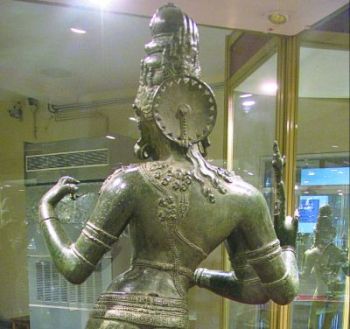
AT THE back of the image, too, great care has been
taken to mark the contrasts. For instance, the scapula of Siva
is rock-like, while that of Parvati appears soft. Also note the
circular 'jata billai' (hair clip). This picture was taken at
the Government Museum, Chennai, from where the bronze was brought
for display at the gallery in Thanjavur.
This Nataraja wears three necklaces – a jewelled necklace,
a beaded one and a rosary of rudraksha berries. His right ear
has a makara kundala (fish-like earring) and the left ear has
a patra kundala (circular scroll earring). Unfortunately, the
jata (the flying hair) and the aureole (tiruvasi in Tamil) with
a series of flames are missing. His right foot is planted firmly
on Muyalakan, or Apasmara (in Sanskrit), the dwarf who stands
for ignorance, and the left foot is poised lightly in the air.
The art historian the late C. Sivaramamurti in his seminal work
Nataraja in Art, Thought and Literature (first published by the
National Museum, New Delhi in 1974) describes this bronze thus:
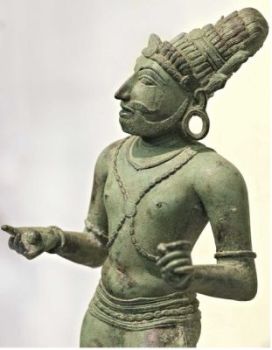
KANNAPPA NAYANAR OF Tiruvengadu. His head
is tilted to the left as he has gouged out his right eye with
the arrow (missing) in his left hand. He has a beard and a fiercemoustache
as befitting the hunter-prince Tinnan he was before he was canonised
as a Saivite saint. He wears a patra kundala or circular scroll-like
earring. Also prominent are the interconnecting belts that run
diagonally across the shoulders.
“To about 1000 A.D. should be assigned the
famous Nataraja of Tiruvalangadu now in the Madras Museum [renamed
Government Museum, Chennai]. It is a classical example and the
best known image of its kind in any public museum in the world.
The pose of this figure, its rhythmic movement, the flexion of
the body and the limbs, the perfect smile, the physical proportions
and the flowing contours are blended into a pose so amazing that
it is no wonder that [Auguste] Rodin, the world famous sculptor,
considered this to be the most perfect representation of rhythmic
movement in the world.”
While Rodin described this metal icon as “perpetual beauty
in bronze”, Ananda K. Coomaraswamy noted that “the grandeur”
of the conception of Ananda tandava was “a synthesis of science
and religion and art”. He called the sthapathis, who made
such astonishing bronzes, “rishi-artists”.
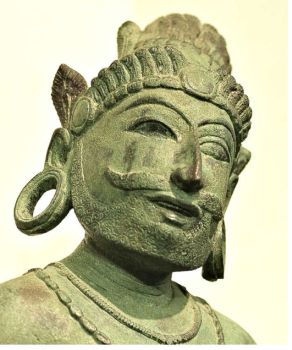
THE SOCKET of the right eye, which has been
gouged out, is hollow. The upper row of teeth can be seen.
Nagaswamy called this Nataraja “a unique contribution of
Tamil Nadu to the world of art and a masterpiece both as an art
specimen and for expressing the high form of philosophy of the
cosmos.” Just as the planets in the cosmos move in a rhythm,
there is a rhythm in the dance of Siva, he says. Tamil artists
visualised Nataraja's dance as “ananda tandava”, which
he danced to the rhythm of the damaru he played.
The sthapathi of this bronze has paid so much attention
to detail that even the workmanship of the flames held by the
Nataraja is “extraordinarily beautiful”, says P.R. Srinivasan
in his book Bronzes of South India, published by the Government
Museum, Chennai, in 1963.
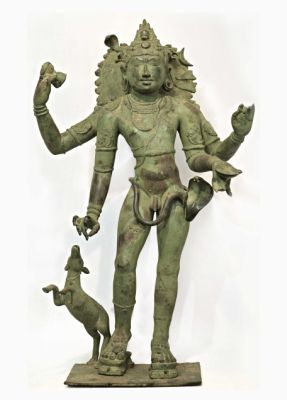
BHIKSHATANA OF TIRUVENGADU. Siva as the young
mendicant whom the wives of the sages of Tarugavanam tried to
seduce. The sthapathi's attention to detail can be discerned in
the matted hair, the crescent upon it, the skull, the third eye
on the forehead, the 'patra kundala' in the left ear, the thick
lips, the aquiline nose, the bell tied to the right shin, and
the bell tied around the neck of the antelope.
Velan (Subrahmanya) of Gangaikonda Cholapuram: The
image commemorates Raja Raja Chola's son Rajendra Chola's (regnal
years 1012-1044 CE) conquest, across the sea, of the Sri Vijaya
kingdom, including Kedah (in the Malaysian peninsula, which formed
part of the larger territory of the then Sri Vijaya kingdom),
Sumatra and Java (both now in Indonesia). Legend has it that the
most outstanding exploit of Subrahmanya, also called Deva Senathipathi,
was his victory over the demon Surapadman at sea.
The bronze shows Velan in his battle accoutrements, a beautiful
smile playing on his serene face. His four hands hold a sword
called Sakthi Padai, given to him by Parvati, a shield, a rooster
and Vajra, the weapon given to him by Indra. He wears a karanda
makuta (tiered crown), a headband, makara kundala (earrings shaped
like fish), udara banda (stomach band) and three pearl necklaces.
The dhoti is held in place by a simha-clasp (buckle resembling
a lion).
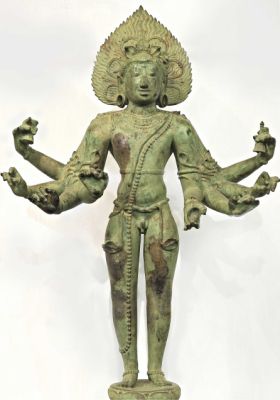
'ENTHOL MUKKAN' OF Tiruvengadu. A rare bronze
in which Siva is depicted with eight arms and three eyes. This
form is marked by a prominent 'jwala' (flame) around his head,
a long chain that runs from the left shoulder almost to the ankle
of the right leg and two cobras coiled around his waist. People
call him 'Ashta Bhairava' and worship him as the protector of
their fields.
Gangaikonda Cholapuram was the capital of Rajendra Chola, a great
temple builder and conqueror like his father. At Gangaikonda Cholapuram
he built a temple, Gangaikonda Cholisvaram, which resembled closely
Raja Rajesvaram. The temple commemorated his conquest of Bengal
and the Gangetic region and his bringing of the water of the river
Ganga to the Chola country. For this, he received the title Gangaikondan
(Conqueror of the Ganga).
R. Balasubramanian, Curator (archaeology), Government Museum,
Chennai, noted that the Velan bronze demonstrated influences of
the Pala style of Bihar and Bengal.

BHADRAKALI, 14TH CENTURY. Suprisingly, she
has a benign face. In her eight hands are weapons such as a discus,
a trishul, an axe and a sword. She also holds a shield, a conch
and a skull cup. She has a 'jwala makuta'.
Ardhanarisvara of Tiruvengadu: This bronze of fabulous workmanship
belongs to the reign of Rajathiraja and is dated to 1045 CE. Ardhanarisvara
is a fusion of Siva and Parvati – the right and left halves
respectively – in a standing posture. It expresses, philosophically,
the union of Siva, the godhead, and Sakti, the divine energy.
Nagaswamy described it as “a masterpiece in art, combining
in itself manliness and female elegance”. The sthapathi has
shown a contra-distinction in every feature – eyes, arms,
shoulders, legs, and even dress and jewellery. The two hands on
Siva's side are strong and muscular, but Parvati's hand (there
is only one) is slender. Siva's shoulder and scapula are rock-like
but Parvati's appear soft. There is a difference in the shape
of the nose, too, on either side. As for the waist, Parvati's
is slender and curvy and Siva's is almost erect. Siva's leg exhibits
strength but Parvati's is lithe. Parvati's eye is fish-like and
Siva's is broad. Siva has a kangan on his wrist while Parvati
wears bangles. Siva wears a pearl necklace and Parvati a gold
chain. Siva is dressed in tiger skin and Parvati in a thin sari
with a series of horizontal pleats.

NEESUMBASUDANI, THE EIGHT-ARMED deity of
the 11th century. All the eight arms are evenly distributed, a
difficult task to achieve. The first hand on her right side must
have held the spear that killed the demon Neesumban. The third
holds a dagger, some of it broken, and the bottom-most one holds
a sword. On her left side, the bottom-most hand holds a 'kapala'
or skull cap, the one just above it has a 'kanda' or bell, the
next one a shield and the one above it depicts the 'viswa maya'
mudra.
The Ardhanarisvara was discovered in 1960, buried in the precincts
of the Svetaranyesvara temple in Tiruvengadu. Nagaswamy, who was
then Curator, Madras Museum, acquired it for the government. He
dated it to 1045 CE from an inscription in the temple. It also
revealed that Thuppaiyan Uthama Choli, a nobleman, donated this
image to the temple.
Kannappa Nayanar of Tiruvengadu: Tinnan, a hunter-prince who lived
in the forested hills near Kalahasthi in present-day Andhra Pradesh,
is venerated in Saivite hagiography as “Kannappa Nayanar”,
one of the 63 Saivite nayanmars (saints). His unparalleled devotion
to Siva was put to the test by Siva himself. During a hunting
expedition, when Tinnan saw an eye of the mukha-linga bleeding,
he gouged out one of his eyes with his arrow and grafted it to
the linga's bleeding eye. No sooner did he do it than the other
eye on the mukha-linga started bleeding. Tinnan had no hesitation
in scooping out his other eye and grafting it on to the linga.
Touched by his piety, Siva restored his vision, and he was called
Kannappa, the devotee who gave his own eyes to Siva.
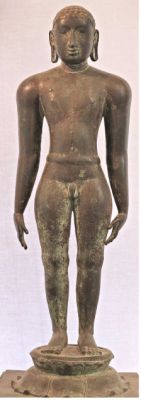
ADHINATHA, THE FIRST Jaina tirtankara. This
bronze was found at Kidangal village near Tindivanam (Villupuram
district), which had an ancient Jaina settlement. This bronze
demonstrates that the sthapathis of that period were as good at
simplicity as they were at intricate workmanship.
Kannappa's bronze is dramatic in its appeal. He stands holding
the gouged-out eyeball in his right hand. His right eye socket
is hollow, and even his upper row of teeth can be seen. He has
a beard, and as befitting a hunter-prince, he sports a fierce
moustache.
“On the palm of Kannappa's extended right hand, we can see
the eyeball, while the manner in which the fingers of the left
hand are bent suggests that they must have held the arrow,”
says Job Thomas in his book Tiruvengadu Bronzes, published by
Cre-A: in 1986. Tinnan wears armlets and wristlets, and a leather
apron, its edges laced with shells. True to his role as a hunter,
he wears rough sandals.

SEATED BUDDHA WITH two Naga attendants, 11th
century. This bronze was found at Nanayakkara street in Nagapattinam.
The Buddha has an aureole around his head. A parasol rises above
it and a highly decorated Bodhi leaf announces that he is seated
under the Bodhi tree. The 'dhyana' pose indicates that the Buddha
has attained enlightenment. A five-headed serpent rears above
the head of each attendant, who hold a fly-whisk in one hand and
depict the 'viswa maya' pose with the other.
Bhikshatana of Tiruvengadu: Siva is every inch a young mendicant
here. In his matted hair are the moon, a skull, a cobra and flowers.
He has four hands. The hand of the upper right arm holds a damaru
and the lower one on that side feeds a leaf to the antelope that
follows him. On the left side, the lower left hand has a skull-cup,
while the upper one must have held a trident. A cobra, with a
big hood, slithers around his waist. The Bhikshatana wears necklaces,
a stomach-band and wooden sandals. A bell tied to his left leg
announces his arrival. Inscriptions reveal that a nobleman, Amalan
Seyyavayar, donated this image to the Tiruvengadu temple.
“Enthol Mukkan,” of Tiruvengadu: Enthol Mukkan (11th
century CE) is a form of Siva that is worshipped by villagers
as the protector of their fields. In some places he is called
A shta Bhairava. He is called Enthol Mukkan because he has eight
hands and three eyes. While two cobras are coiled around his waist,
two more have entwined themselves around his upper arms.
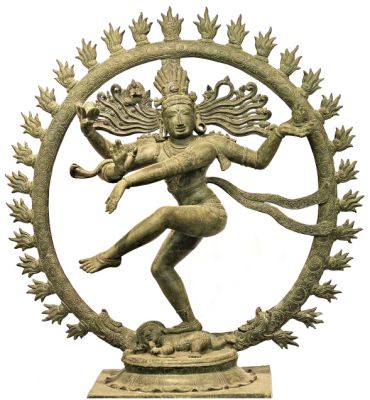
NATARAJA OF KULASEKARA Nallur, near Thanjavur.
This 12th century masterpiece was found fully intact. While the
hand at the top on his right side plays the damaru, the one below
is in the 'abhaya' (protection) mudra. On the left side, the top
hand holds a flame and the one below it is in the 'gaja-hasta'
pose. Around his neck are several pearl necklaces, and there are
highly embellished bands on the forearms and wrists.
Kali: She is seated and has eight hands and, surprisingly, a benign
face.
Neesumbasudani: This image is dramatic as the deity, with eight
hands, is poised to spear a demon. In the hands are a kapala (skull
cup), kanda (bell), dagger, sword and shield. One of the hands
portrays the viswa maya (sense of wonder) mudra. While one hand
is broken, in the other the trishul she usually wields is missing.
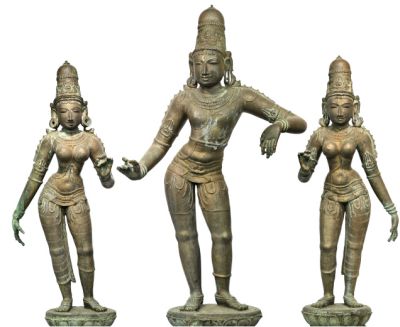
KRISHNA WITH SATYABHAMA (left) and Rukmani.
This group belongs to Tiruvarur, of the 11th century. Rukmani
is not a common representation in Chola bronzes. Note the embellishments
on the dresses and on the jewellery.
All eight hands in each of the three bronzes – ‘Enthol
Mukkan', Kali and Neesumbasudani – are distributed evenly,
a task that is difficult to achieve in metal art, said Nagaswamy.
Veenadhara Dakshinamurthy: This was “a rare piece” on
display, said Balasubramanian. It is datable to the 10th century
CE and belongs to Mayiladuthurai, Thanjavur. Dakshinamurthy, who
is the fount of all knowledge, is shown as playing the veena,
but the veena is missing.
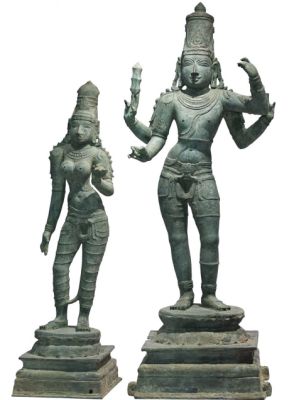
MURUGAN AND VALLI. These were found in the compound of
a house in Velankanni near Nagapattinam in July 2010 along with
several other images, including those of several Saivite saints.
All these belong to the 12th century. Velankanni was an ancient
Saivite centre.
Krishna, Sathyabhama and Rukmani: The group comprising Krishna
with Sathyabhama and Rukmani has been worked on intricately. This
group belongs to the early Chola bronzes of the 11th century from
Tiruvarur near Thanjavur. Rukmani is represented but rarely in
Chola bronzes.
On display from the Tiruvarur hoard were also a beautiful Rama,
Devi and Nandi, all belonging to the 11th century.
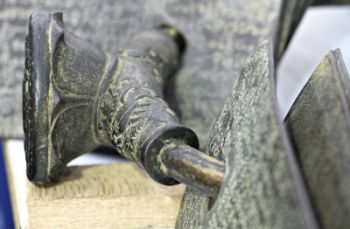
THE BIGGEST COPPER plate charter discovered
anywhere so far, with 86 leaves fastened on a ring that has the
Chola royal emblem. It was issued by Rajathiraja Chola in 1053
CE and was among the hoard unearthed at Tiruindalur village in
May 2010.
Buddhas and Tirtankaras: They formed an eclectic collection. Two
exquisite Buddhas, one standing and the other seated on a throne
with two Naga attendants, were from Nagapattinam.
Nagapattinam, in Tamil Nadu, was an important port on the east
coast and a flourishing maritime trade centre in ancient India.
It lay on one of the two sea routes to India from China and became
an important centre of learning and pilgrimage for Buddhists from
China, Sri Lanka and Kadaram (Kedah). Between 1856 and the 1930s,
about 350 Buddha bronzes were found at Vellipalayam and Nanayakkara
Street in Nagapattinam.
In the estimate of T.N. Ramachandran, former Joint Director-General
of the Archaeological Survey of India, the discovery of 350 Buddhas
“unfold an interesting phase of Nagapattinam's history and
have recovered for us a lost page in the history of South Indian
Buddhism” (The Nagapattinam and other Buddhist Bronzes in
the Chennai Museum, first published in 1954).
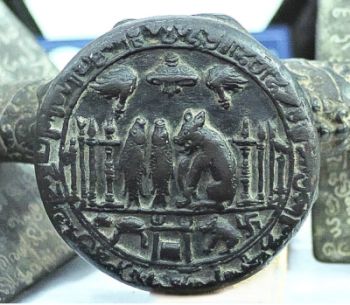
The royal emblem up close. The 'tiger' was the symbol
of the Cholas, and the fish, the bow and the boar were the emblems
of the Pandyas, the Cheras and the Chalukyas respectively, whom
Raja Raja Chola conquered. The emblem has two fly-whisks and a
parasol. It also has auspicious symbols, such as lamps, incense
stands and a conch.
Nagapattinam was a Buddhist centre even during the Pallava rule.
The Pallava king Rajasimha (circa 690-728 CE) built a Buddha vihara
there. It was an established Buddhist centre when Raja Raja Chola
ascended the throne in Thanjavur in 985 CE.
The Sri Vijaya king Sri Mara Vijayotunga Varman sent an emissary
from Kedah to Raja Raja Chola, requesting his permission to build
a Buddha vihara near Nagapattinam in the name of his father Sri
Chulamani Varman. Raja Raja Chola granted permission and also
gifted wealth and a village, Anaimangalam near Nagapattinam, for
this in 1006 CE. This is recorded in Raja Raja Chola's copper
plate charter called Anaimangalam Grant, now displayed in the
Leiden Museum in the Netherlands.
The seated Buddha, according to Nagaswamy, is “an illustrious
example of a Buddhist bronze from the age of Raja Raja Chola”.
Two Naga attendants, holding fly-whisks, stand behind the Buddha.
This small, 73-cm-tall bronze of riveting beauty was found in
Nanayakkara Street in 1934. The Buddha's hands are in the dhyana
pose, indicating attainment of knowledge, and he is seated in
the Padmasana posture. Behind the Buddha is a prabha in three
parts with beautiful designs. There is a circular aureole around
the Buddha's head with 35 flames. The Buddha's ear lobes are broad
and proportionate to the face. He has seven rows of curls of hair,
with an “ usnisa” (flame of knowledge) on top.
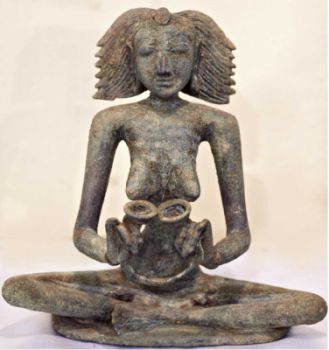
KARAIKAAL AMMAIYAR, ONE of the 63 Saivite
saints in Tamil Nadu. This bronze is part of the Tiruindalur hoard.
It has a great sense of verisimilitude with the Ammaiyar who was
emaciated on account of the extreme forms of penance she undertook
for a vision of the dancing Siva.
In this bronze, the arresting features are the symmetrical Naga
attendants, one on either side of the Buddha. Each of them has
one hand holding a fly-whisk and the other showing the viswa maya
mudra. Five serpent hoods placed above their heads indicate their
Naga nature, while their personal attire and ornaments indicate
their regal status.
An Adinatha bronze of the 13th century was found at Kidangal near
Tindivanam, which was an ancient Jaina settlement in Tamil Nadu.
At the rear of the pedestal of the bronze is an inscription that
says “Vakkiran Kizhar” made this image as a votive offering.
Kulasekara Nallur bronzes: Another important group of bronzes
that were displayed belonged to Kulasekara Nallur, a village near
Tiruvidaimaruthur in Thanjavur district. A treasure trove of bronzes,
including a dancing Siva (Nataraja), and puja vessels was found
at Konruzham Pallam, just outside Kulasekara Nallur, a few decades
ago. These bronzes belong to the period of Kulotunga Chola II
and are datable to 1150 CE. Unlike his Tiruvalangadu counterpart,
the Nataraja of Kulasekara Nallur was found fully intact and is
of ethereal beauty. Also found was a metal image of Sivakami.
Some of the puja vessels had epigraphs that mention the name “Ethirili
Chola”. The entire group was consecrated by Ethirili Chola,
who was popularly known as Kulotunga Chola II.
Recent discoveries: Also on display were three hoards of bronzes,
a massive copper plate charter with a big Chola royal emblem,
metal trumpets and puja articles, all of which were unearthed
at Tiruindalur, Velankanni and Vedaranyam this year. The hoard
found in the Kailasanatha temple in Tiruindalur village (Nagapattinam
district) had 13 beautiful bronzes, the biggest-ever copper plate
charter with 86 leaves, two trumpets called “Ekkalam”
in Tamil, and puja vessels.
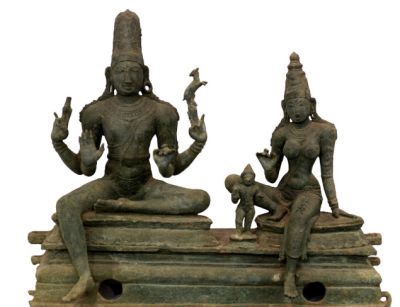
SIVA AND PARVATI with Skanda. This Somaskanda
group of small bronzes was a part of 13 bronzes discovered at
the Kailasanatha temple in Tiruindalur village. The outer arm
on the right side holds the 'mazhu', or the axe, Siva's weapon,
and the one in front depicts the 'abhaya' posture. On the left
side, the outer arm holds an antelope and the one in front depicts
the 'ahuya (blessing) mudra.
Nagaswamy dated the bronzes to 1053 CE. He described them as “a
fantastic find” and said they belonged to the period of Rajathiraja
Chola but in the earlier metal-casting tradition of Raja Raja
Chola. The bronzes included that of Karaikaal Ammaiyar, two standing
Ganeshas, Appar, Sundarar with his wives Sangili and Paravai,
a dancing Tirugnana Sambandar, Manickavasagar, Chandikesvara,
Chandrasekhara with his consort, and the Somaskanda group comprising
Siva, Parvati and Skanda.
A bronze where the atelier has wrought his consummate skill is
that of Karaikaal Ammaiyar who undertook extreme penance to have
a beatific vision of the dancing Siva. She looks every inch emaciated
in this artefact. In his book Nataraja in Art, Thought and Literature,
Sivaramamurti pays a lot of attention to different icons of Karaikaal
Ammaiyar, belonging to the Chola period.
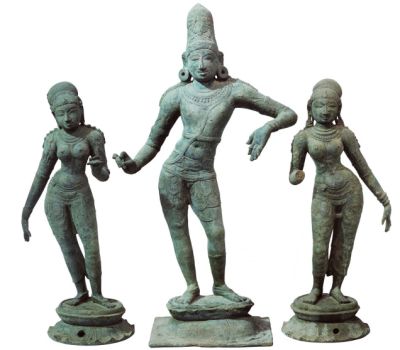
SAIVITE SAINT SUNDARAR with his wives Sangili
(left) and Paravai. These were part of the 13 bronzes found in
Tiruindalur village in Nagapattinam district in May 2010. Note
the embellishments on their dresses and also on the bangles, anklets
and necklaces.
The Velankanni hoard, datable to the 12 century, included Tripurantaka,
the Somaskanda group, Appar, Tirugnana Sambandar and Manickavasagar,
Subrahmanya with his consorts Valli and Deivanai, and a four-armed
Ganesa.
As Nagaswamy said, these bronzes were wrought with such consummate
skill by master-craftsmen that “it is difficult to say which
[one] is not a masterpiece”.
http://www.frontline.in/stories/20101119272305800.htm